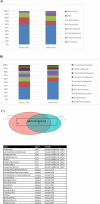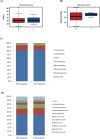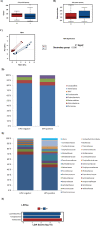HPV infection and bacterial microbiota in breast milk and infant oral mucosa
- PMID: 30395655
- PMCID: PMC6218085
- DOI: 10.1371/journal.pone.0207016
HPV infection and bacterial microbiota in breast milk and infant oral mucosa
Abstract
Objective: We investigated the association between bacterial microbiota in breast milk and the infant mouth. The influence of human papilloma virus (HPV) infection on infant oral microbiota was also assessed.
Material and methods: Altogether 35 breast milk and 35 infant oral samples with known HPV status were selected from the Finnish Family HPV Study cohort. In total, there were 31 mother-infant pairs. The microbiota composition was characterized by 16S rRNA gene sequencing (V3-V4 region).
Results: HPV DNA was present in 8.6% (3/35) of the breast milk and 40% (14/35) of the infant oral samples. Eight shared genera between breast milk and infant oral were found; these included Streptococcus, Staphylococcus, Unclassified Gemellaceae, Rothia, Veillonella, Haemophilus, Propionibacterium and Corynebacterium. HPV status was not associated with either microbiota richness or diversity in the infant mouth. However, the infant oral microbiota clustered in different groups according to HPV status. We detected higher abundance of Veillonella dispar (p = 0.048) at species level in HPV negative infant oral samples. We did not detect differences in the breast milk microbiota composition related to HPV infection due to only three HPV positive milk samples.
Conclusions: HPV infection is associated with distinct oral bacterial microbiota composition in infants. The direction of causality underlying the phenomenon remains unclear.
Conflict of interest statement
The authors have declared that no competing interestest exist.
Figures





Similar articles
-
16S rRNA amplicon sequencing identifies microbiota associated with oral cancer, human papilloma virus infection and surgical treatment.Oncotarget. 2016 Aug 9;7(32):51320-51334. doi: 10.18632/oncotarget.9710. Oncotarget. 2016. PMID: 27259999 Free PMC article.
-
Breast Milk Is a Potential Vehicle for Human Papillomavirus Transmission to Oral Mucosa of the Spouse.Pediatr Infect Dis J. 2017 Jul;36(7):627-630. doi: 10.1097/INF.0000000000001546. Pediatr Infect Dis J. 2017. PMID: 28604561
-
Strong Multivariate Relations Exist Among Milk, Oral, and Fecal Microbiomes in Mother-Infant Dyads During the First Six Months Postpartum.J Nutr. 2019 Jun 1;149(6):902-914. doi: 10.1093/jn/nxy299. J Nutr. 2019. PMID: 31063198 Free PMC article.
-
Breast milk microbiota: A review of the factors that influence composition.J Infect. 2020 Jul;81(1):17-47. doi: 10.1016/j.jinf.2020.01.023. Epub 2020 Feb 6. J Infect. 2020. PMID: 32035939 Review.
-
Human Milk Microbiota: Origin and Potential Uses.Nestle Nutr Inst Workshop Ser. 2020;94:75-85. doi: 10.1159/000505031. Epub 2020 Mar 13. Nestle Nutr Inst Workshop Ser. 2020. PMID: 32172230 Review.
Cited by
-
Metataxonomic Analysis of Milk Samples From SARS-CoV-2-Positive and SARS-CoV-2-Negative Women.Front Nutr. 2022 Mar 18;9:853576. doi: 10.3389/fnut.2022.853576. eCollection 2022. Front Nutr. 2022. PMID: 35369105 Free PMC article.
-
Oral Human Papillomavirus Associated With Differences in Oral Microbiota Beta Diversity and Microbiota Abundance.J Infect Dis. 2022 Sep 21;226(6):1098-1108. doi: 10.1093/infdis/jiac010. J Infect Dis. 2022. PMID: 35038733 Free PMC article.
-
What's Normal? Microbiomes in Human Milk and Infant Feces Are Related to Each Other but Vary Geographically: The INSPIRE Study.Front Nutr. 2019 Apr 17;6:45. doi: 10.3389/fnut.2019.00045. eCollection 2019. Front Nutr. 2019. PMID: 31058158 Free PMC article.
-
Human papilloma virus (HPV) profiles in breast cancer: future management.Ann Transl Med. 2020 May;8(10):650. doi: 10.21037/atm-19-2756. Ann Transl Med. 2020. PMID: 32566587 Free PMC article. Review.
-
Composition and maternal origin of the neonatal oral cavity microbiota.J Oral Microbiol. 2019 Sep 5;11(1):1663084. doi: 10.1080/20002297.2019.1663084. eCollection 2019. J Oral Microbiol. 2019. PMID: 31528268 Free PMC article.
References
-
- Giuliano AR, Nyitray AG, Kreimer AR, Campbell CMP, Goodman MT, Sudenga SL, et al. EUROGIN 2014 Roadmap: Differences in HPV infection natural history, transmission, and HPV-related cancer incidence by gender and anatomic site of infection HHS Public Access. Int J Cancer Int J Cancer June. 2015; - PMC - PubMed
-
- Betiol J, Villa LL, Sichero L. Impact of HPV infection on the development of head and neck cancer. Brazilian J Med Biol Res = Rev Bras Pesqui medicas e Biol [Internet]. 2013. March [cited 2018 Jan 17];46(3):217–26. Available from: http://www.ncbi.nlm.nih.gov/pubmed/23532264 - PMC - PubMed
-
- Aakko J, Kumar H, Rautava S, Wise A, Autran C, Bode L, et al. Human milk oligosaccharide categories define the microbiota composition in human colostrum. Benef Microbes [Internet]. 2017. August 24 [cited 2018 Jan 17];8(4):563–7. Available from: http://www.wageningenacademic.com/doi/10.3920/BM2016.0185 - DOI - PubMed
-
- Cacho NT, Harrison NA, Parker LA, Padgett KA, Lemas DJ, Marcial GE, et al. Personalization of the Microbiota of Donor Human Milk with Mother’s Own Milk. Front Microbiol [Internet]. 2017 Aug 3 [cited 2018 Jan 17];8:1470 Available from: http://journal.frontiersin.org/article/10.3389/fmicb.2017.01470/full - DOI - PMC - PubMed
-
- Biagi E, Quercia S, Aceti A, Beghetti I, Rampelli S, Turroni S, et al. The Bacterial Ecosystem of Mother’s Milk and Infant’s Mouth and Gut. Front Microbiol [Internet]. 2017 Jun 30 [cited 2018 Jan 17];8:1214 Available from: http://journal.frontiersin.org/article/10.3389/fmicb.2017.01214/full - DOI - PMC - PubMed
Publication types
MeSH terms
Substances
LinkOut - more resources
Full Text Sources

